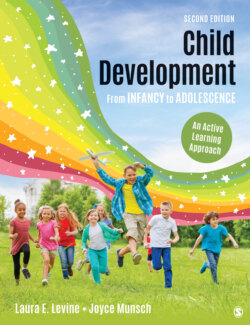Читать книгу Child Development From Infancy to Adolescence - Laura E. Levine - Страница 127
На сайте Литреса книга снята с продажи.
Ecological Theory
ОглавлениеWe tend to think of the study of ecology as focusing on plants and animals and their relationships to the environment, but in the 1970s, Urie Bronfenbrenner (1917–2005) applied the idea of how organisms interact with their environment to the field of developmental psychology to create a human ecological theory. Using this framework, he defined development as the “interaction between the developing organism and the enduring environments or contexts in which it lives out its life” (Bronfenbrenner, 1975, p. 439). Bronfenbrenner believed we cannot understand the life course of an individual without understanding how that person interacts with all the different facets of his environment. He also believed this interaction is a dynamic process. All aspects of the environment affect the individual, and the individual affects all aspects of his environment.
Ecological theory: Bronfenbrenner’s concept of development as a result of the interaction between an individual and a nested system of influences.
Bronfenbrenner (1977, 1986) proposed that development occurs within a nested set of influences that he divided into five systems: the microsystem, mesosystem, exosystem, macrosystem, and chronosystem as shown in Figure 2.6. These systems are embedded one within the other, each influencing the other in a back-and-forth fashion. Bronfenbrenner emphasized the importance of understanding the individual, not on her own or with one or two other people, but rather within all these contexts. His theory is, in part, a criticism of some of the techniques of experimental psychology, in which children are tested in the laboratory and the results are then assumed to be true in the child’s natural setting (Bronfenbrenner, 1977).
Urie Bronfenbrenner. Urie Bronfenbrenner developed ecological theory to explain the importance of the different contexts in which children develop.
Cornell University
The microsystem includes the face-to-face interactions a person has in her immediate settings, such as home, school, or friendship groups. The interaction between a mother and a child forms a microsystem, as does the interaction between a child and a peer, or between a pair of siblings. The mesosystem brings together two settings that contain the child. For example, when parents meet and talk to a child’s teacher, the home setting interacts with the school setting and this interaction influences the child’s progress at school. The exosystem consists of settings the child never enters, that is, that are external to the child, but that affect the child’s development nevertheless (Bronfenbrenner, 1986). For example, even if the child never goes to a parent’s workplace, what happens in that setting can have an effect on the child. A job so demanding that it leaves parents exhausted at the end of the day affects the way parents will interact with children when they come home. The macrosystem consists of cultural norms that underlie the institutions and activities that make up someone’s everyday life. For example, the macrosystem in the United States includes the ideology of democracy, as well as the value placed on individual achievement. The chronosystem consists of the events that take place at different times in a child’s life, as well as the time in history in which the child lives. For example, parental divorce affects a 2-year-old child much differently than a teenager. Also, the current experience of divorce, when it has become more common, is different than it would have been in 1940 when it was relatively rare (Bronfenbrenner, 1986).
Microsystem: In ecological theory, the face-to-face interaction of the person in her immediate settings, such as home, school, or friendship groups.
Mesosystem: In ecological theory, the interaction among the various microsystems, such as a child’s school and home.
Exosystem: In ecological theory, settings that the child never enters but that affect the child’s development, such as the parents’ place of work.
Macrosystem: In ecological theory, cultural norms that guide the nature of the organizations and places that make up one’s everyday life.
Chronosystem: In ecological theory, the dimension of time, including one’s age and the time in history in which one lives.
Description
Figure 2.6 Bronfenbrenner’s ecological systems model.
Source: Adapted from Bronfenbrenner and Morris, 2006, as cited in Kuther, 2017.
It will be easier for you to remember the various systems that make up ecological theory if you are able to recognize examples of each of them. Active Learning: Examples of Ecological Systems gives you a chance to do this.
Active Learning: Examples of Ecological Systems
Match each description below with the correct level of the ecological system it represents. The levels are the microsystem, mesosystem, macrosystem, exosystem, and chronosystem.
Answers: (1) chronosystem, (2) mesosystem, (3) macrosystem, (4) microsystem, (5) macrosystem, (6) exosystem, (7) mesosystem, (8) chronosystem, (9) microsystem, (10) exosystem
